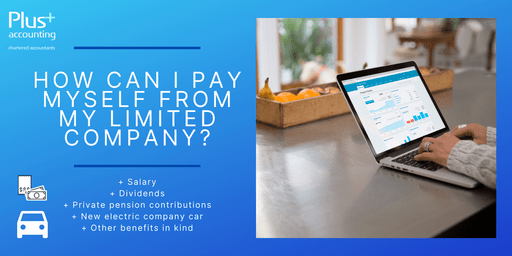For many people venturing out on their own for the first time with their newly formed limited company’s, there will undoubtedly be questions about what differences there are to their previous role as an employee. Unsurprisingly the variation in workload and responsibilities between the two are vastly different but one of, if not the, major difference is how you pay yourself. Without the simplicity and regularity of a payrolled salary, which you would receive from your previous employment, this can seem like a momentous task, but in this article, I hope to simplify the options available and make this decision easier to make.
Why would you take a lower salary
Using a director’s salary as a form of remuneration is the most straightforward method of paying yourself, as the income tax and national insurance rates are the same as any other employment held previously. The main difference for a director is that, as they are not bound by minimum wage legislation, there is the option available to vote a lower salary up to the secondary national insurance threshold to utilise better tax planning methods through a combination of low salary and dividends (see below). Salaries are also not limited to the company’s retained profits in the same way that dividends, are meaning that where businesses may be loss making, there is a greater availability of remuneration through this method. Furthermore, gross wages and employers’ national insurance contributions are deductible for corporation tax purposes meaning that company will be making a 19% corporation tax saving at the same time. In addition, an eligible proportion of these salary costs would be available for Research and Development tax relief where qualifying projects are undertaken.
Why would you take a higher salary
The greatest draw back to using a salary is the higher income tax and national insurance implications. Salaries are taxable at a higher percentage than dividends. Depending on the gross salary, the tax rate can be as high as 45% if an individual’s total income is above the additional tax threshold. In addition, there is also employee’s national insurance charged at 12% on salary exceeding the primary threshold up to the upper earnings threshold and 2% above this. Furthermore, salaries are required to be reported through a payroll scheme, which may mean the business incurs payroll operating costs on top of the higher income tax and national insurance rates. As mentioned above, these expensive repercussions of drawing a salary can be negated if a lower director’s salary up to the secondary threshold is taken. The obvious issue this causes is that there is a lower amount owed to the director and available for drawing, especially if there are no reserves available to top this figure up with dividends.
Paying yourself in dividends
For a long time, dividends have been one of the cheapest methods for shareholders to draw money from their limited company. The rate of tax for dividend income when compared to employment income (salary) is significantly lower with the 2022/23 rates being 8.75% for basic rate taxpayers, 33.75% for higher rate taxpayers and 39.35% for additional rate taxpayers when compared to 20/40/45% respectively for employment income. All UK taxpayers also benefit from a tax-free dividend allowance of £2,000 each year. On top of this, dividend income is not liable to national insurance meaning that there is a 12% additional saving on voting dividends for the individual over an equivalent salaried amount, as well as the company saving money in employers national insurance contributions. Additionally, dividends voted by a company do not need to be processed through a payroll scheme which can save companies money in processing charges and allow for more immediate flexibility in remuneration paid in both a cash sense and from a tax planning perspective.
The largest draw back for a lot of companies, especially those who are just starting, is that dividend availability is restricted to a company’s available retained earnings. What this means is that if company’s have not built up a sufficient level of reserves in the current or previous years, they may be prevented from remunerating their shareholders at the level they want to. This leads on to another problem in that dividends can only be voted to shareholders in a company not directors. This can make it harder to vote dividends as, under an ordinary share structure, dividends would need to be voted in line with the percentage stake held by the shareholders in the business making tax planning even more difficult and mean that to utilise this method of remuneration for future employee’s or investors in the company existing shareholders would likely have to lose a percentage of their ownership. From an operational perspective, another downside to voting dividends is that recipients will likely have to complete a self-assessment tax return each year to report this income and pay the tax this is owed due to this not being collected at source. Finally, there is no corporation tax relief on dividends paid, which not only will result in a high corporation tax liability at the end of the year compared to if this amount was paid through a salary, but also for those company’s applying for Research and Development tax relief, this remuneration will not be a qualifying cost.
Indirect methods of remuneration
The aforementioned forms of remuneration are the two most direct methods of paying directors and shareholders, but there are also other indirect methods of remunerating directors and staff which can be especially beneficial for profitable company’s looking to reduce their corporation tax liability.
Private pension contributions by limited company
Separate to any workplace pension scheme, limited companies can also make payments into employee’s or directors private pension schemes. Where personal contributions into the scheme are often limited by earnings, employer contributions from a limited company directly to a private scheme have a much higher annual limit of £40,000 and the ability to carry forward unused contributions for the previous three years. On top of this higher availability, any contributions made by a limited company can also be allowable for corporation tax purposes, meaning the company could potentially save 19% of the total contribution in corporation tax. Furthermore, contributions into a private pension scheme are not treated as personal income for tax purposes and so any payments made are not taxable personally allowing for further tax planning options when looking at a total remuneration package.
As with any pension scheme, the funds held are not available for drawing until the individual is at the qualifying pension age without incurring a large tax charge, which means this can take a long time for the employee to obtain these funds. Also, as the pension contributions must be physically paid, this will impact the company’s cashflow and reserves, meaning that there will be less available resources to pay dividends or invest in other business assets. Due to the complexity of the available allowances carried forward and the variety of pension providers out there we would also always recommend enquiring into the services of an Independent Financial Advisor before opening a new pension scheme.
New electric company car
In the past, company cars have become less desirable due to the high benefit in kind implications of receiving this form of remuneration. However, in the past few years the government has announced a new lower benefit in kind rate for fully electric cars of 2% from 2022/23 onwards. When compared to existing rates for petrol, diesel, and hybrid cars this is a lot lower and when extrapolated into real terms the end tax liability for the benefit received is very low. If the vehicle is brand new, the limited company will also receive a 100% first year allowance on the cost of the car and this will be held as an asset on the company’s balance sheet. The first-year allowance will mean that in practice the company will receive a 19% saving on their corporation tax bill of the price of the asset. Moreover, as the vehicle will be an asset of the company, any maintenance or repair costs of the vehicle can be paid by the company and deductible for corporation tax purposes.
As well as the cash flow effect the purchase of a brand-new car would have on company resources, another issue is that if the electric car is not brand new the company will not receive the 100% first year allowance making a big cut into the initial tax savings. The company would still receive writing down allowances each year, but this does not offer the same level of immediate taxable savings. In addition to this, providing a benefit in kind would lead to the requirement to complete a P11D form each year which requires additional time and effort as well as a class 1a national insurance charge to the company of 13.8% of the beneficial value. The final, and potentially biggest, real-world issue with this method is that the electric car market is still in its relatively infant years meaning there isn’t a great deal of affordable options readily available on the market which can lead to some company’s being priced out of using this.
Other non-taxable benefits
There are certain other benefits that can be provided to directors and staff which would not create a taxable benefit in kind. One of these is the provision of a work mobile phone. If the plan is in the company’s name, the employee can receive one work phone before this is deemed a taxable benefit and the costs of buying the phone and the ongoing contract payments would be deductible for corporation tax purposes. There is also the option to provide trivial benefits to employees and directors which are small tax-free gifts that are deductible for corporation tax purposes. The rules are slightly different for employees and directors and these can be found on the HMRC website. Another benefit that can be provided without incurring a benefit in kind charge is the operation of a relevant life insurance policy. There are strict rules surrounding which schemes are not deemed as a taxable benefit and so we would recommend speaking to your accountant before setting up such a scheme.

Author: Sam Baldwin, Business Services Manager, Plus Accounting
Any views or opinions represented in this blog are personal, belong solely to the blog owner and do not represent those of Plus Accounting. All content provided on this blog is for informational purposes only. The owner of this blog makes no representations as to the accuracy or completeness of any information on this site or found by following any link on this site
Date published: 29 April 2021
Updated : 21 April 2022


